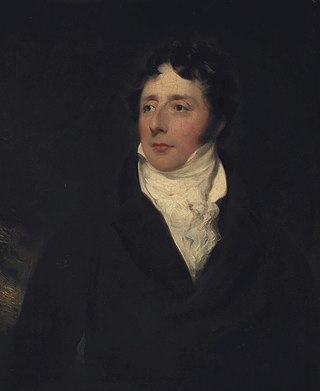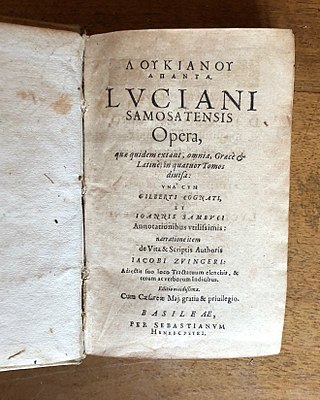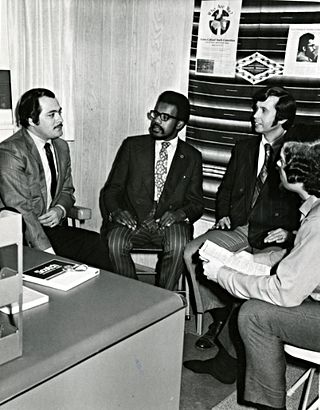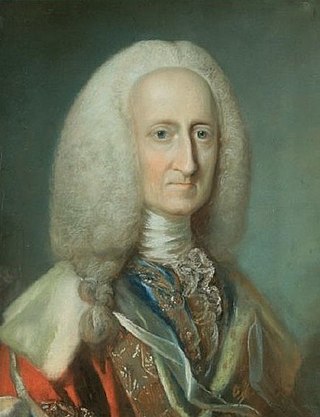Related Research Articles

Robert Southey was an English poet of the Romantic school, and Poet Laureate from 1813 until his death. Like the other Lake Poets, William Wordsworth and Samuel Taylor Coleridge, Southey began as a radical but became steadily more conservative as he gained respect for Britain and its institutions. Other romantics such as Byron accused him of siding with the establishment for money and status. He is remembered especially for the poem "After Blenheim" and the original version of "Goldilocks and the Three Bears".

Lucian of Samosata was a Hellenized Syrian satirist, rhetorician and pamphleteer who is best known for his characteristic tongue-in-cheek style, with which he frequently ridiculed superstition, religious practices, and belief in the paranormal. Although his native language was probably Syriac, all of his extant works are written entirely in ancient Greek.

Dialogue is a written or spoken conversational exchange between two or more people, and a literary and theatrical form that depicts such an exchange. As a philosophical or didactic device, it is chiefly associated in the West with the Socratic dialogue as developed by Plato, but antecedents are also found in other traditions including Indian literature.

Menippus of Gadara was a Cynic satirist. The Menippean satire genre is named after him. His works, all of which are lost, were an important influence on Varro and Lucian, who ranks Menippus with Antisthenes, Diogenes, and Crates as among the most notable of the Cynics.

Walter Horatio Pater was an English essayist, art and literary critic, and fiction writer, regarded as one of the great stylists. His first and most often reprinted book, Studies in the History of the Renaissance (1873), revised as The Renaissance: Studies in Art and Poetry (1877), in which he outlined his approach to art and advocated an ideal of the intense inner life, was taken by many as a manifesto of Aestheticism.

Walter Savage Landor was an English writer, poet, and activist. His best known works were the prose Imaginary Conversations, and the poem "Rose Aylmer," but the critical acclaim he received from contemporary poets and reviewers was not matched by public popularity. As remarkable as his work was, it was equalled by his rumbustious character and lively temperament. Both his writing and political activism, such as his support for Lajos Kossuth and Giuseppe Garibaldi, were imbued with his passion for liberal and republican causes. He befriended and influenced the next generation of literary reformers such as Charles Dickens and Robert Browning.

Edward Dowden was an Irish critic, professor, and poet.

Ancient Greek literature is literature written in the Ancient Greek language from the earliest texts until the time of the Byzantine Empire. The earliest surviving works of ancient Greek literature, dating back to the early Archaic period, are the two epic poems the Iliad and the Odyssey, set in an idealized archaic past today identified as having some relation to the Mycenaean era. These two epics, along with the Homeric Hymns and the two poems of Hesiod, Theogony and Works and Days, constituted the major foundations of the Greek literary tradition that would continue into the Classical, Hellenistic, and Roman periods.

George Lyttelton, 1st Baron Lyttelton,, known between 1751 and 1756 as Sir George Lyttelton, 5th Baronet, was a British statesman. As an author himself, he was also a supporter of other writers and as a patron of the arts made an important contribution to the development of 18th-century landscape design.
Caroline Anne Southey was an English poet and painter. She became the second wife of the poet Robert Southey, a prominent writer at the time.

Anne-Thérèse de Marguenat de Courcelles, who on her marriage became Madame de Lambert, Marquise de Saint-Bris, and is generally known as the Marquise de Lambert, was a French writer and salonnière.
Simon the Shoemaker was an associate of Socrates, and a 'working-philosopher'. He is known mostly from the account given in Diogenes Laërtius' Lives and Opinions of Eminent Philosophers. He is also mentioned in passing by Plutarch and Synesius; a pupil of Socrates, Phaedo of Elis, is known to have written a dialogue called Simon.

Sir Sidney Colvin was a British curator and literary and art critic, part of the illustrious Anglo-Indian Colvin family. He is primarily remembered for his friendship with Robert Louis Stevenson.

John Hughes was an English poet, essayist and translator. Various of his works remained in print for a century after his death, but if he is remembered at all today it is for the use others made of his work. Texts of his were set by the foremost composers of the day and his translation of the Letters of Abelard and Heloise was a major source for Alexander Pope's Eloisa to Abelard.
An imaginary voyage is a kind of narrative in which utopian or satirical representation is put into a fictional frame of travel account.

Aesop was a Greek fabulist and storyteller credited with a number of fables now collectively known as Aesop's Fables. Although his existence remains unclear and no writings by him survive, numerous tales credited to him were gathered across the centuries and in many languages in a storytelling tradition that continues to this day. Many of the tales associated with him are characterized by anthropomorphic animal characters.

A novel is a relatively long work of narrative fiction, typically written in prose and published as a book. The present English word for a long work of prose fiction derives from the Italian: novella for "new", "news", or "short story of something new", itself from the Latin: novella, a singular noun use of the neuter plural of novellus, diminutive of novus, meaning "new". Some novelists, including Nathaniel Hawthorne, Herman Melville, Ann Radcliffe, John Cowper Powys, preferred the term "romance" to describe their novels.
The instance that marked the shift in the whole of Arabic literature towards modern Arabic literature can be attributed to the Arab World-West contact during the 19th and early 20th century. This contact resulted in the gradual replacement of Classical Arabic forms with Western ones. Genres like plays, novels, and short stories were coming to the fore. Although the exact date in which this reformation in literary production occurred is unknown, the rise of modern Arabic literature was "inseparable" from the Nahda, also referred to as the Arab Renaissance.

Gebir is a long poem by the English writer Walter Savage Landor. The poem was first published anonymously in English in July 1798, before being revised and republished in 1803, in dual, separate Latin and English editions.
References
- ↑ Sidney Colvin, Landor (1881), ch. V, p. 98ff]
- ↑ The Athenaeum, 1876, p.167
- ↑ Colvin 1881, p.107
- ↑ "Imaginary Conversation between Mr Walter Savage Landor and the Editor of Blackwood’s Magazine", Eclectic Museum of Foreign Literature, Science and Art, Volume 2 (1843), pp.311-325
- ↑ PMLA 38.4 (1923), "Walter Savage Landor as a Critic of Literature"
- ↑ Imaginary Connversations, 1883 composite edition
- ↑ vol. III, 1876 edition
- ↑ vol. IV, 1876 edition
- ↑ vol. V, 1876 edition
- ↑ Vol. VI, 1876 edition
- ↑ Colvin 1881, p.100
- ↑ The Longer Prose Works of Walter Savage Landor, J. M. Dent, 1893, vol. 2, p. 132
- ↑ Colvin 1881, p.99
- ↑ Adrian J Wallbank, Dialogue, Didacticism and the Genres of Dispute: Literary Dialogues in the Age of Revolution, Routledge 2015, p.214
- ↑ The Oxford History of Classical Reception in English Literature, OUP 2012, vol. 4, p.42
- ↑ The New Lucian, a series of dialogues of the dead, Chapman and Hall, pp.59-84
- ↑ Book 7, "A Quarrel between Tiberius, Gaius Caligula, and Valeria Messalina"
- ↑ George Armstrong Kelly, Mortal Politics in 18th Century France, Berghahn Books 1986, pp.75-102
- ↑ University of Ghent
- ↑ Wellcome Collection
- ↑ Gutenberg
- ↑ Hathi Trust
- ↑ Online archive
- ↑ Woo-Lih Dun Ho, Goldsmith's Chinese Letters through Chinese Eyes, Boston University Graduate School 1950, p.3
- ↑ Enc. Brit. 9th edition, vol.14, p.280
- ↑ The Gay Science, Dover Thrift Edition (2020), p.79
- ↑ Google Books
- ↑ Land & Sea Tales For Scouts and Guides, "An English School"